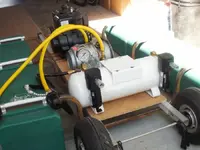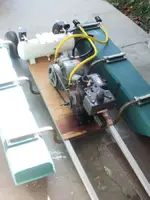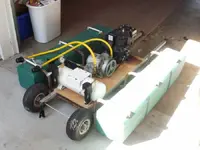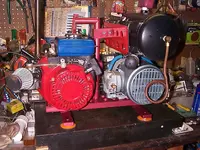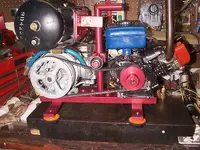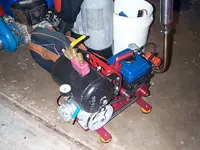In addition to the comments already posted, I would add the following;
1. The intakes appear to be far to low. On my dredge, a 4", I put the intake filters on 4 foot HDPVC interior water pipe with swivel mounts. This allows for the mast to be dropped for transport, and to move onsite with prevailing winds in mind. I also have CO detectors at the filters, and realize that any CO is bad, as the pump is compressing it.
2. The pulley on the gas motor appears far to small of a diameter. Given that the gas motor has no load other than the pump, you have to get the RPM/LOAD curves from each part to optimize the assembly. The noted compressor, I believe, has working RPM of 1450, the gas motor, with the load of the compressor, likely has a working clean burn RPM near 1800. That would dictate the pulleys being very similar in size.
Again, the RPM/Load curves are available for the compressor and the gas motor from the manufacturer, just get each, and match up the pulley diameters to the RPM on the curves.
3. I am not familiar with the compressor, but is there a dump valve included in the assembly? If not, you would need to add one to the storage tank.
4. I would consider making the line from the compressor to the storage tank a solid copper or other solid metal line. The constant heat and pressure will make short work of that hose, the extended length shown may have an interesting result under pressure as well, so be careful.
5. It appears that this is a common compressor for dredge applications, so are there guidelines for the size of the storage/expansion tank? With a dual head, this tank appears very small, if nothing else, for heat dissipation. Perhaps a 5 gallon tank is more appropriate, but again, there must be guidelines somewhere.
Side note: while I can only postulate, breathing overly warm compressed air, may have an effect on your lungs, the alveoli in your lungs already warm up with the absorption of oxygen. Other gasses, which divers use such as tri-mix and helium, absorb much faster on a binary level, hence the lungs heat up with rate of absorption. Thus mixed gas divers have a very high risk of lung burn, and with SAT divers, an absolute. In conclusion, I would warn that breathing the compressed air at elevated temperatures may be a health risk, so it would be best to avoid the risk.
Remember, this is your life support. Choose wisely.
Good luck!



